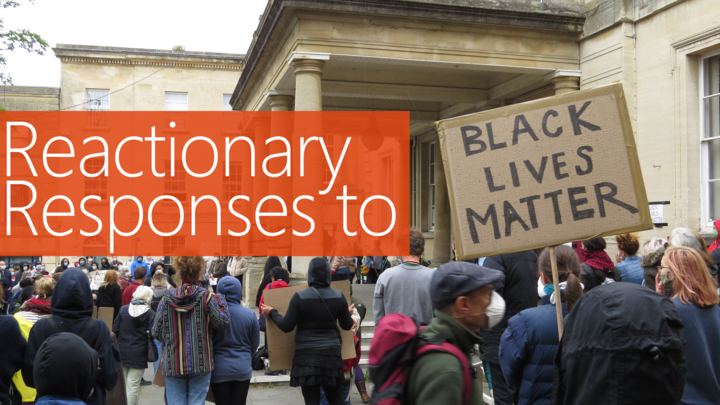Reactionary responses to Black Lives Matter


By Sean Buckley
The popularity of the Black Lives Matter cause has steadily risen since its reappearance on the streets of Minneapolis in the aftermath of the murder of George Floyd and a seemingly endless numbers of public figures have voiced their support. Cultural figures such as actors and musicians have been vocal advocates for the cause, while politicians remain more split, as they often are, which is possibly reflective of the deeper divide seen more broadly in public discourse, particularly on social media.
We at Amplify published a piece recently focusing on the phrase ‘All Lives Matter’ and the denialist perspective that underpins its use. Anecdotally, it appeared the most common retort repeated by those speaking out against the Black Lives Matter protests. In the Facebook comment section during our promotion of the piece, however, it seems those who were already parroting the phrase incessantly would rather double down on their criticism of Black Lives Matter.
There are two specific arguments reiterated en masse as criticisms of protests occurring in the UK and abroad. Firstly, that the protests should be condemned as social distancing regulations have been broken during the protests. Secondly, the argument commonly repeated by many politicians and mainstream news outlets is that isolated acts of looting, violence and destruction of property (public or private) also justify condemnation of the entire movement.
The issue of social distancing not being respected is definitely a serious one, especially here in the UK and over in the US where government incompetence has delivered the highest coronavirus death tolls in the world. The reason we have sunk to this horrific honour, however, is because the government was wilfully slow to react to the incoming crisis and made a decision, consciously or not, to sacrifice marginalised and vulnerable communities in a decidedly failed attempt to lessen the economic impact of Covid-19. The ONS report concerning ethnicity and coronavirus indicates that ethnic minority households are at a significantly increased risk. Black individuals alone are around 1.9 times more likely to die from Covid-19 than white ones. BAME communities are more likely to live in overcrowded households; around 15% of Black and around a third of Bangladeshi households are considered overcrowded, compared to 2% of white households. BAME people are also less likely to be employed in a profession that can be done from home, and are overrepresented in frontline areas like transport and care work.
This economically biased, ideological decision brought to light the easy devaluation of human life under our current system. Indeed, it is because of the current health crisis that the protests against racial prejudice are so important, and why they resonated globally in the way they have.
Equally condemned throughout these events is the destruction of property and looting: something that is arguably a valid form of protest when the subject of the protest is a system which explicitly values property over human life. Philosopher Guy Debord presents an excellent case for this.
Looting is a natural response to the unnatural and inhuman society of commodity abundance. It instantly undermines the commodity as such, and it also exposes what the commodity ultimately implies: the army, the police and the other specialised detachments of the state’s monopoly of armed violence. What is a policeman? He is the active servant of the commodity, the man in complete submission to the commodity, whose job it is to ensure that a given product of human labor remains a commodity, with the magical property of having to be paid for, instead of becoming a mere refrigerator or rifle — a passive, inanimate object, subject to anyone who comes along to make use of it. In rejecting the humiliation of being subject to police, black people are at the same time rejecting the humiliation of being subject to commodities.
Guy Debord – The Decline and Fall of the Spectacle-Commodity Economy, (1965)
Mainstream politicians, pundits and commentators have all presented the argument that disrespect of private property is a disservice to the cause protestors are trying to promote. It is however, in no uncertain terms, the embodiment of it. George Floyd was murdered for allegedly using a forged $20 bill to buy cigarettes. Current methods of policing, at home and abroad, have for years systematically prioritised the preservation of property over human life. That so many are more disgusted by the destruction of property and the looting of businesses than death is the purest manifestation of a broken system one can imagine.
The removal of statues has become a centralised topic of discussion throughout these events, especially in the UK after the toppling of a statue in Bristol commemorating slaver Edward Colston, and its subsequent introduction to the harbour floor. Those arguing for their removal state that the statues in question glorify the often horrendous acts committed by their subjects, largely in service of economic exploitation and colonialism, and to leave them be is to tacitly condone these actions. Most arguing against their removal have acknowledged that justifying the actions of the statues’ likeness is a little too overtly racist, and instead maintain that they should remain as reminders of history. The failure of this argument is that these statues were often not erected in the eras they represent, instead built to evoke a memory of a glorious past and emphasise a political perspective. Confederate statues in the U.S. were mostly erected during the Jim Crow era by white nationalists intending to glorify a romanticised memory of the Confederacy. The Colston statue, supposedly inspired by his work as a philanthropist, was erected in 1895; 170 years after his death and over half a century after the abolition of slavery in the UK. The act of removal has done far more to educate the populace on Colston’s legacy than his presence ever did: remembering history and learning from it is rapidly becoming a central facet of the national discourse. Because they occupy public spaces a statue will only ever function symbolically, rather than provide any nuanced historical context, statues and monuments simply as a format have negligible effect on people’s real education. Funding museums, history departments, libraries and schools would have a much more direct and measurable impact. Attempting to preserve them, while rejecting calls for rethinking the national history curriculum, is to only acknowledge the ideals the sculpture represents.
Condemnation of the violence during the protests taking place over the last few weeks has a tendency to ignore the prevailing trend that is the instigation of that violence by the police forces called in to regulate them. Unprovoked use of weaponry and tear gas brings tensions to a high, and exacerbates the anger the participants were already feeling. Endless footage has provided evidence of unnecessary police overreactions. Would the logic that frames all protestors as responsible for irresponsible acts of violence by a few not also place the responsibility for acts of horrific and racially prejudiced violence on all members of that police force?
Framing the protestors as the exclusive instigators of violence works as an effective tactic to turn public opinion against the protestors cause. Civil Rights campaigns in the 60s provide some insight to this. After the assassination of Martin Luther King, Jr. in 1968, the media coverage shifted to a message orientated around the need to control violent protests. The supposed knock on effect being the defeat of Hubert Humphreys, lead author of the 1964 Civil Rights Act, by Richard Nixon at the polls shortly afterwards. King himself spoke to the white moderate’s preference for maintenance of order over the demand for justice. To cast all violent protest as inherently wrong is an easy argument to latch onto for those who disagree with the cause behind it. Abstracting the violence from any context provides a simplified and effective point with which to alter public opinion. It is because it is simplified to such an extent it is a clearer and more definable concept to rally against than systemic oppression. Systemic issues, by their nature, are normalised to the degree which they are ignored by mainstream discourse. It brings into question what the white public values, both here and in the US. The white moderate’s desire for order above justice appears to have stayed steadfast since 1968.
At the time of writing, far-right protesters have amassed in central London with the purpose of defending the statue of Winston Churchill and the cenotaph. Video footage immediately circulated across social media of individuals throwing Nazi salutes, and of the marchers instigating fistfights with the police in attendance. The message they are attempting to get across is somewhat muddled however. Amassing in direct ideological opposition to the BLM protests, yet electing to attack the very police force they were supposedly in agreement with. The reaction of the press so far has been to condemn this violence in the same manner violent incidents at BLM protests were condemned. The order of the status quo misrepresented as non-violent. As of yet little attention has been paid to the ideological motivations behind this reactionary event. They are ostensibly there to protect some monuments, but have quickly descended into hurling slurs and fighting law enforcement. Much like the BNP and EDL (both heavily represented in the crowds) they like to position themselves as an ideological antithesis to BLM, but are largely incapable of articulating any political argument.
Political ideologies all justify violence in some context. Currently that justification resides in authoritarian oppression via the actions of a police force. Both this and the use of military force overseas to secure profits for private enterprise are the direct and explicit legacy of Britain’s colonial past. All violence is condemned as if all violence is morally equivalent. However, it should be clear that acts perpetrated in the defence of perpetual systemic brutality are unequivocally immoral in contrast to violence attempting to end that same systemic oppression.
The people marching in London today are unmistakably fascist in their intentions and ideals. They seek to explicitly defend authoritarian and racially motivated violence, and the figureheads that symbolise it. Advocation and defence of figures that participated so significantly in the maintenance of a system that expressly benefits from racial violence and oppression should be taken for no more than the white nationalism that it is. To cherry pick figures and narratives from history, and ‘defend’ these monuments demonstrates both a complete disregard and misunderstanding of historical context and the desperate need to react against anything that could progress the status of minorities in this country.
It would appear hilarious if it were not so insidious that so many are that egregiously lacking in self awareness as to throw Nazi salutes in front of war memorials and the Churchill statue. Why is it that patriotism has been so often coerced into an attempt to erase historical wrongs? Would it not be in the interest of the true patriot to acknowledge the history of the nation, and work to alleviate the circumstances left to us by legacy?






Member discussion